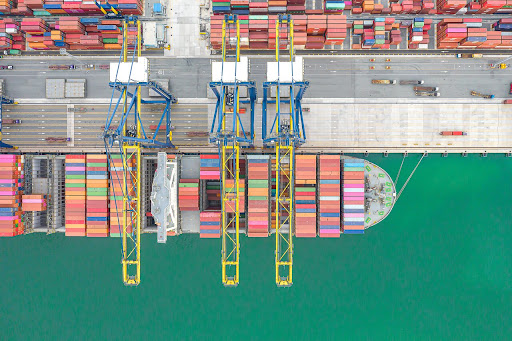Understanding the cost of logistics services is essential for organizations to make informed decisions about supply chain management. By understanding these intricacies, businesses can identify areas for improvement, enhance operational efficiency, and ultimately drive profitability. In this blog post, we delve into the world of logistics costs and explore the different components that contribute to overall expenses.
What Factors Affect Logistics Costs?
When it comes to determining the cost of logistics services, several factors come into play. Understanding these factors is crucial for businesses to effectively manage their supply chain expenses.
Let’s explore some of the key elements that can influence logistics costs:
- Transportation: Transportation costs often constitute a significant portion of logistics expenses. Factors such as distance, mode of transport (road, rail, air, sea), fuel prices, tariffs, tolls, and regulatory requirements can impact transportation costs. Additionally, factors like the urgency of delivery, shipment volume, and seasonal fluctuations can influence the overall expenditure.
- Warehousing and Inventory: The cost of warehousing and inventory management is another critical aspect of logistics expenses. Warehouse space, lease or rent, labor costs, technology and automation investments, insurance, security, and maintenance expenses all contribute to the overall warehousing costs. Efficient inventory management, including storage, handling, and obsolescence, also affects the financial aspect of logistics operations.
- Packaging: Packaging plays a vital role in protecting goods during transportation and storage. However, it also adds to logistics costs. Factors like the type of packaging material, design complexity, durability, customization requirements, and compliance with regulations can impact packaging costs. Additionally, eco-friendly or sustainable packaging options may have different cost implications.
- Customs and Duties: In international trade, customs duties and tariffs can significantly impact logistics costs. These costs are influenced by factors such as the nature of goods, origin and destination countries, trade agreements, customs regulations, and compliance requirements. Import and export duties, taxes, and customs brokerage fees all contribute to the overall expenses.
- Infrastructure and Facilities: The quality and availability of infrastructure, such as roads, ports, airports, and railways, can affect logistics costs. Efficient transportation networks, well-maintained facilities, and advanced technology integration can enhance operational efficiency and reduce costs. Conversely, inadequate infrastructure can lead to delays, increased transportation expenses, and additional handling charges.
- Supply Chain Complexity: The complexity of a company’s supply chain can impact logistics costs. A complex supply chain with multiple suppliers, manufacturing locations, distribution centers, and customer locations can result in higher transportation and inventory costs. Streamlining the supply chain, consolidating shipments, and optimizing routes can help mitigate these expenses.
- Service Level Requirements: The level of service expected by customers also influences logistics costs. Factors such as delivery speed, tracking capabilities, special handling requirements, and customer-specific services impact the entire cost. Balancing service quality with cost-effectiveness is crucial to meet customer expectations while maintaining profitability.
By analyzing and understanding these factors, businesses can identify areas for cost optimization, streamline their logistics processes, negotiate better contracts with service providers, and ultimately enhance their bottom line.
The 5 Main Factors That Influence Logistics Costs
1. Transportation Expenses
Transportation expenses can add up quickly, especially when considering the fuel, maintenance, and labor required to keep goods moving efficiently. it’s essential for logistics providers to continuously evaluate and improve their logistics chains to optimize transportation expenses while maintaining high levels of service quality for their clients’ shipments.
One major factor that affects transportation expenses is shipping rates. For instance, trucking companies have different rates than those specializing in air and sea travel, and not keeping a close eye on how these variable costs affect profit margins can substantially increase supply chain costs. In addition, rates can vary depending on the distance traveled, the type of goods being transported, and any additional services required.
How do logistics companies handle shipping and transportation?
2. Warehousing and Storage Costs
Warehousing and storage costs are a significant aspect of overall logistics expenses. Whether it’s a small logistics company or a large supply chain management operation, managing storage cost calculations efficiently is crucial to keeping operations profitable.
The standard cost of leasing or owning warehouse facilities adds up over time. Logistics companies often have to pay for the physical space they use to store goods. Additionally, there are maintenance expenses such as utilities and security measures that need to be factored into the overall warehousing and storage costs. Efficient utilization of available space becomes essential as every square foot has a financial impact.
Inventory management is another crucial factor contributing to warehousing and storage costs. Effective inventory control ensures that stock levels are optimized, minimizing excess inventory while meeting customer demand. Keeping track of stock movement, organizing products efficiently within the warehouse, and implementing proper labeling systems all contribute to efficient inventory management.
By streamlining these processes, logistics service providers can reduce the carrying costs associated with storing excess materials. Warehousing and storage costs play a significant role in determining logistics expenses for companies involved in supply chain management.
3. Inventory Management and Optimization
Robust inventory management is essential for optimizing logistics activities while minimizing costs. By strategically organizing your storage facility and adopting efficient practices such as real-time tracking systems and collaborative supply chain coordination, you can achieve higher operational efficiency.
Optimizing inventory management involves various strategies such as implementing real-time tracking systems, utilizing automated replenishment processes, and analyzing historical data to forecast demand accurately. By doing so, you can minimize the risk of stockouts while reducing the amount of capital tied up in excess inventory.
Furthermore, effective inventory management is closely linked to supply chain coordination. Collaborating with suppliers and streamlining inbound shipments allows for better synchronization between production cycles and demand fluctuations. By maintaining a healthy relationship with suppliers and optimizing transportation routes, you can reduce lead times and lower logistics expenses associated with inbound flows.
4. Labor and Manpower Expenses
Finding the right balance between in-house staff and third-party logistics providers while considering logistics investments enables you to minimize overall logistics costs while maintaining excellent service levels. One way to do this is by carefully assessing your staffing needs and ensuring that you have the right number of employees with the necessary skills to handle the workload efficiently. By avoiding overstaffing or understaffing, logistics companies can avoid unnecessary labor costs.
Another way to optimize labor and manpower expenses is by exploring the option of outsourcing certain tasks to third-party logistics service providers. These professionals specialize in specific areas of logistics, such as warehousing, transportation, or order fulfillment. By leveraging their expertise and resources, you can reduce the need for in-house staff and potentially save on labor costs. Additionally, third-party logistics providers often offer additional services like inventory management or value-added services that can further enhance your operational efficiency.
Optimizing labor and manpower expenses allows companies to improve their bottom line while also enhancing cash flow management. This allows an organization to allocate resources strategically across other areas of its business, such as marketing or product development.
5. Technology and Automation
Incorporating technology and automation into logistics services is an effective strategy to manage expenses more effectively. With advanced software solutions for inventory management and automated systems for warehouse operations, companies can achieve greater accuracy, speed, and cost-efficiency in fulfilling customer orders.
Automation technologies like robotics can significantly improve warehouse operations by increasing productivity and reducing labor costs. These technologies enable tasks such as picking, packing, and sorting to be carried out efficiently without human intervention.
With the help of software solutions, companies can keep track of their stock levels in real-time, allowing them to pay special attention to product availability at all times. This reduces the risk of overstocking or understocking, ultimately optimizing inventory management and minimizing expenses associated with carrying excess stock.
How can I choose the right logistics company for my business?
Cost Reduction Techniques in Logistics Services
Managing and reducing logistics costs is a constant challenge for businesses seeking to optimize their supply chain operations. By implementing cost-reduction strategies, companies can improve their financial performance while maintaining service quality.
Here are some effective techniques to consider:
- Efficient Route Planning: Optimizing transportation routes can lead to significant cost savings. By leveraging advanced route management software and considering factors such as distance, traffic patterns, fuel consumption, and delivery schedules, businesses can minimize transportation expenses. Consolidating shipments and utilizing load optimization techniques can further enhance efficiency and reduce costs.
- Consolidation and Collaboration: Collaborative logistics efforts, such as consolidation of shipments with other businesses or partnering with third-party logistics providers (3PLs), can yield cost savings. By sharing transportation and warehousing resources, companies can benefit from economies of scale, reduce empty miles, and optimize space utilization. Collaborative efforts also offer opportunities for better negotiation with service providers, resulting in favorable pricing.
- Inventory Management: Effective inventory management practices can significantly impact logistics costs. Maintaining an optimal inventory level, reducing carrying costs, and minimizing stockouts or overstock situations can lead to cost savings. Implementing just-in-time (JIT) inventory systems, adopting demand forecasting techniques, and improving inventory accuracy through technology solutions can help reduce inventory-related expenses.
- Warehouse Efficiency: Enhancing warehouse efficiency can lead to cost reductions. Streamlining warehouse operations, improving space utilization, implementing automation and technology solutions, and optimizing labor utilization can minimize handling and storage costs. Additionally, employing effective inventory control mechanisms, such as cycle counting or ABC analysis, can reduce inventory holding costs and improve order fulfillment accuracy.
- Supplier Collaboration: Collaborating closely with suppliers can yield cost-saving opportunities. Establishing strong relationships, negotiating favorable terms, and exploring alternative sourcing options can help reduce procurement costs. Additionally, implementing vendor-managed inventory (VMI) or consignment arrangements can transfer inventory ownership and associated carrying costs to suppliers.
- Technology Integration: Leveraging technology solutions can drive efficiency and cost savings in logistics operations. Implementing transportation management systems (TMS), warehouse management systems (WMS), inventory tracking tools, and real-time visibility platforms can improve operational visibility, automate processes, and reduce manual errors. Technology also enables data analysis for identifying cost-saving opportunities, optimizing routes, and enhancing overall supply chain performance.
- Continuous Improvement and Data Analysis: Embracing a culture of continuous improvement and data-driven decision-making is essential for cost reduction in logistics services. Regularly analyzing operational data, identifying bottlenecks or inefficiencies, and implementing process improvements can lead to cost savings. Employing key performance indicators (KPIs) and performance benchmarking can help monitor progress and drive ongoing cost optimization efforts.
Logistics Services
At Axil Transport, we specialize in providing comprehensive solutions for shipping and logistics. Thanks to our vast industry expertise and state-of-the-art supply chain technology, we can help you achieve optimal direct logistics costs while providing premium services to your customers.




